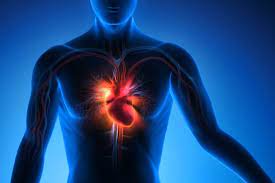A heart attack happens when something blocks the blood flow to your heart so it can’t get the oxygen it needs.
More than a million Americans have heart attacks each year. Heart attacks are also called myocardial infarctions (MI). “Myo” means muscle, “cardial” refers to the heart, and “infarction” means death of tissue because of a lack of blood supply. This tissue death can cause lasting damage to your heart muscle..
Heart Attack Symptoms
Symptoms of a heart attack include:
- Discomfort, pressure, heaviness, tightness, squeezing, or pain in your chest or arm or below your breastbone
- Discomfort that goes into your back, jaw, throat, or arm
- Fullness, indigestion, or a choking feeling (it may feel like heartburn)
- Sweating, upset stomach, vomiting, or dizziness
- Severe weakness, anxiety, fatigue, or shortness of breath
- Fast or uneven heartbeat

Symptoms can be different from person to person or from one heart attack to another. Women are more likely to have these heart attack symptoms:
- Unusual fatigue
- Shortness of breath
- Nausea or vomiting
- Dizziness or lightheartedness
- Discomfort in your gut. It may feel like indigestion.
- Discomfort in the neck, shoulder, or upper back
With some heart attacks, you won’t notice any symptoms (a “silent” myocardial infarction). This is more common in people who have diabetes.
Angina
Angina isn’t a condition or disease. It’s a symptom, and sometimes it can signal a heart attack. The sensations may occur with normal activities or exertion but then go away with rest or when you take nitroglycerin.
- Pressure, pain, squeezing, or a sense of fullness in the center of the chest
- Pain or discomfort in the shoulder, arm, back, neck, or jaw
Call 911 if it gets worse, lasts more than 5 minutes, or doesn’t improve after you’ve taken nitroglycerin. Doctors call that “unstable” angina,” and it’s an emergency that could be related to a heart attack that is about to happen.
If you instead have “stable” angina, which is the most common kind, your symptoms usually happen with predictable triggers (such as a strong emotion, physical activity, extreme hot and cold temperatures, or even a heavy meal). The symptoms go away if you rest or take nitroglycerin that your doctor has prescribed. If not, call 911.

Heart Attack Causes
Your heart muscle needs a constant supply of oxygen-rich blood. Your coronary arteries give your heart this critical blood supply. If you have coronary artery disease, those arteries become narrow, and blood can’t flow as well as it should. When your blood supply is blocked, you have a heart attack.
Fat, calcium, proteins, and inflammatory cells build up in your arteries to form plaques. These plaque deposits are hard on the outside and soft and mushy on the inside.
When the plaque is hard, the outer shell cracks. This is called a rupture. Platelets (disc-shaped things in your blood that help it clot) come to the area, and blood clots form around the plaque. If a blood clot blocks your artery, your heart muscle becomes starved for oxygen. The muscle cells soon die, causing permanent damage.
Rarely, a spasm in your coronary artery can also cause a heart attack. During this coronary spasm, your arteries restrict or spasm on and off, cutting off the blood supply to your heart muscle (ischemia). It can happen while you’re at rest and even if you don’t have serious coronary artery disease.
Each coronary artery sends blood to a different part of your heart muscle. How much the muscle is damaged depends on the size of the area that the blocked artery supplies and the amount of time between the attack and treatment.
Your heart muscle starts to heal soon after a heart attack. This takes about 8 weeks. Just like a skin wound, a scar forms in the damaged area. But the new scar tissue doesn’t move the way it should. So your heart can’t pump as much after a heart attack. How much that ability to pump is affected depends on the size and location of the scar.

What Do I Do if I Have a Heart Attack?
After a heart attack, you need quick treatment to open the blocked artery and lessen the damage. At the first signs of a heart attack, call 911. The best time to treat a heart attack is within 1 or 2 hours after symptoms begin. Waiting longer means more damage to your heart and a lower chance of survival.
If you’ve called emergency services and are waiting for them to arrive, chew an aspirin (325 mg). Aspirin is a potent inhibitor of blood clots and can lower the risk of death from a heart attack by 25%.
When Do I Do if Someone Else Has a Heart Attack?
Call 911 and start CPR (cardiopulmonary resuscitation) if someone goes into cardiac arrest, which is when the heartbeat has stopped and the person isn’t responsive. CPR doesn’t restart the heart; but it keeps the person alive until medical help arrives.
An easy-to-use device called an AED (automated external defibrillator) is available in many public places and can be used by almost anyone to treat cardiac arrest. This device works by shocking the heart back into a normal rhythm.
Here’s how to use an AED:
1. Check responsiveness
- For an adult or older child, shout and shake the person to confirm whether they’re unconscious. Do not use AED on a conscious person.
- For an infant or young child, pinch their skin. Never shake a young child.
- Check breathing and pulse. If absent or uneven, prepare to use the AED as soon as possible.
2. Prepare to use AED
- Make sure the person is in a dry area and away from puddles or water.
- Check for body piercings or outline of an implanted medical device, such as a pacemaker or implantable defibrillator.
- AED pads must be placed at least 1 inch away from piercings or implanted devices.
3. Use AED
For newborns, infants, and children up to age 8, use a pediatric AED, if possible. If not, use an adult AED.
- Turn on the AED.
- Wipe the chest dry.
- Attach pads.
- Plug in connector, if necessary.
- Make sure no one is touching the person.
- Push the “Analyze” button.
- If a shock is advised, check again to make sure no one is touching the person.
- Push the “Shock” button.
- Start or resume continue compressions.
- Follow AED prompts.
4. Continue CPR
- After 2 minutes of CPR, check the person’s heart rhythm. If it’s still absent or uneven, give them another shock.
- If a shock isn’t needed, continue CPR until emergency help arrives or the person begins to move.
- Stay with the person until help arrives.
Heart Attack Diagnosis
Emergency medical workers will ask you about your symptoms and do some tests.
Tests to diagnose a heart attack
Your doctor may order tests including:
EKG: Also known as an electrocardiogram or ECG, this is a simple test that records the electrical activity of the heart. It can tell how much your heart muscle has been damaged and where. It can also monitor your heart rate and rhythm.
Blood tests: Several blood tests, often done every 4 to 8 hours, can help diagnose a heart attack and spot any ongoing heart damage. Different levels of cardiac enzymes in your blood can indicate heart muscle damage. These enzymes are usually inside the cells of your heart. When those cells are injured, their contents — including the enzymes — spill into your bloodstream. By measuring the levels of these enzymes, your doctor can find out the size of the heart attack and when it started. Tests can also measure troponin levels. Troponins are proteins inside heart cells that are released when the cells are damaged by the lack of blood supply to your heart.
 The Care Up
The Care Up




